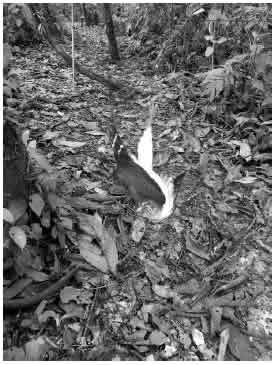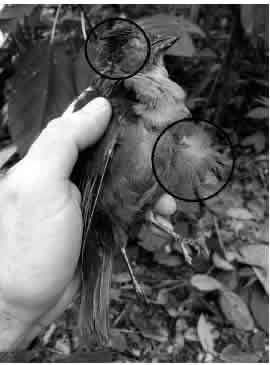Food is an essential resource for all animals, and quantifying their diet is one of the first steps to understand the ecology of a species (Sih and Christen- sen 2001). Recognizing the kind of food a species eats, and how, why and where this resource was obtained, can help to understand their feeding ecology (Kushlan 1979, Granzinolli and Motta-Junior 2007). However, there are few studies on the diet of neotropical birds and, in many cases, the known data are scarce from a scientific basis (Fierro-Calderón et al. 2006).
The Semiplumbeous Hawk (Leucopternis semi plumbeus) is a bird of prey distributed from eastern- most Honduras to northwest tropical Ecuador, from sea level to 1600 masl (Stiles and Skutch 1989, Fergu- son-Lees and Christie 2001, Bierregaard et al. 2020). It has also been observed and heard in Mishana and San Martín, northern Peru (Alonso et al. 2012). This hawk inhabits tropical and subtropical humid forest zones, being able to live in the forest edge and in forest fragments, but it rarely comes out to open areas (Stiles and Skutch 1989, Ferguson-Lees and Christie 2001, Garrigues and Dean 2014, Bierregaard et al. 2020). In Costa Rica, the Semiplumbeous Hawk is a common resident in Caribbean lowlands and foothills, seldom found above 500 masl (Stiles and Skutch 1989, Ga rrigues and Dean 2014). This species is classified as Least Concern according to the IUCN (International Union for the Conservation of Nature) Red List, and its populations are reduced and threatened according to the LCVS (Ley de Conservación de Vida Silvestre) (SINAC 2017, BirdLife International 2020).
The Semiplumbeous Hawk is known to prey mainly on lizards (e.g., Ameiva spp.) and snakes, but it may eat amphibians, small mammals (e.g., bats), birds and probably also feeds on arthropods (Stiles and Skutch 1989, Ferguson-Lees and Christie 2001, Bierregaard et al. 2020). There are reports of this spe- cies attacking birds following army ants and preying on nestlings (Ferguson-Lees and Christie 2001, Visco and Sherry 2015, Menezes and Marini 2017, Bierre gaard et al. 2020). However, there is no specific infor- mation at genera or species level of the birds that are part of the Semiplumbeous Hawk's diet.
The Red-throated Ant-Tanager (Habia fuscicauda) is a small bird distributed from eastern Mexico to northern Colombia from sea level to 1200 masl (Stiles and Skutch 1989, Chiver and Morton 2020). It is clas- sified as Least Concern according to the IUCN Red List and it is not threatened according to the LCVS (SINAC 2017, BirdLife International 2020). This species inha- bits the undergrowth of humid to semiarid evergreen and semi-deciduous forests, edge habitats (including banks of streams and rivers), shady second-growth forests, woodlands, thickets, and overgrown dense plantations (Stiles and Skutch 1989, Garrigues and Dean 2014, Chiver and Morton 2020). In Costa Rica, it is fairly common to find the Red-throated Ant-Tanager in Caribbean lowlands and foothills up to 900 masl (Stiles and Skutch 1989, Garrigues and Dean 2014).

Figure 1: Semiplumbeous Hawk (Leucopternis semiplumbeus) tangled in the mist net, Tirimbina Biological Reserve, Costa Rica. (Photo: Sergio Villegas).

Figure 2: Dead Red-Throated Ant-Tanager (Habia fuscicauda) with signs of predation highlighted (blood on the head and some loose feathers), Tirimbina Biological Reserve, Costa Rica (Photo: Sergio Villegas).
The Red-throated Ant-Tanager has been repor- ted as prey of the Ferruginous Pygmy-Owl (Glauci- dium brasilianum) during the breeding season (Willis 1961, Chiver and Morton 2020). However, there are no reports of Semiplumbeous Hawks preying on Red-throated Ant-Tanagers. The following report represents the first record of an event of this kind.
observation
The incident took place at a mist net installed as part of a study with White-collared Manakin (Mana- cus candei) on 2 June 2017, on a trail in the riparian forest at the Tirimbina Biological Reserve, La Virgen de Sarapiquí, Heredia, Costa Rica (10°25’N, 84°07’W; 180 masl). At 16:00 h, I found two birds tangled in a mist net, a Semiplumbeous Hawk (Fig. 1) and a fema- le Red-Throated Ant-Tanager (Fig. 2). The ant-tanager was dead and had signs of predation (it had blood on the head and some loose feathers; Fig. 2). Since the
observation was made after the prey had already been killed and the two individuáis were trapped in the mist net, the entire predation event was not re- corded. However, nearly three hours before (at 13:15 h) I had seen an individual of Semiplumbeous Hawk perched on a nearby (3 m above the ground) branch of the mist net. After I untangled both individuals, I released the hawk, placed the tanager on the forest floor (away from the site), closed the mist net, and left in order to avoid disturbance.
discussion
The Semiplumbeous Hawk hunts by dropping onto prey (including birds) from low perches and fora- ges throughout the understory and under the canopy (Stiles and Skutch 1989, Ferguson-Lees and Christie 2001). This could be an opportunistic event in which the hawk was perched and possibly took advantage of the tanager being entangled in the mist net to capture it. This behavior has been recorded in this species be- fore, when an individual flew into a mist net to grasp a small passerine that was trapped (Ferguson-Lees and Christie 2001). However, in this record, at the time the Semiplumbeous Hawk captured the prey, it also got entangled. This opportunistic behavior has been re- gistered in other Leucopternis birds (e.g., Komar 2003, Gelis and Greeney 2007), which take advantage of small passerines that are injured or trapped in mist nets (Ferguson-Lees and Christie 2001, Komar 2003, Garske and Andrade 2004).
Likewise, this event could have been favored by the fact that both predator and prey share a similar habitat, as they are fairly common in Caribbean lowlands and foothills, being also found at similar al- titudinal ranges in Costa Rica (Stiles and Skutch 1989, Garrigues and Dean 2014). Moreover, Red-throated Ant-Tanagers sometimes participate in army ant raids and it is known that the Semiplumbeous Hawk can attack birds that are following army ants (Stiles and Skutch 1989, Ferguson-Lees and Christie 2001).
This evidence on the predation of a Red-throated Ant-Tanager by a Semiplumbeous Hawk contributes to the knowledge about its natural history, as few stu- dies exist on its diet, being this the first where a pre- dated bird is identified at the genera or species level. Therefore, this record allows for a better understan- ding of the feeding habits of this bird of prey.
acknowledgments
I gratefully acknowledge José David Salas for helping me with the revision and preparation of this paper. I also thank Luis Sandoval and Tirimbina Biological Reserve for helping me with the funds for the research project (during which I made this report) and lodging. The use of mist nets was conducted under permits from the Tirimbina Biological Reserve and the Universidad de Costa Rica. I also want to thank the two anonymous reviewers for suggestions that improved the manuscript.












 uBio
uBio 

